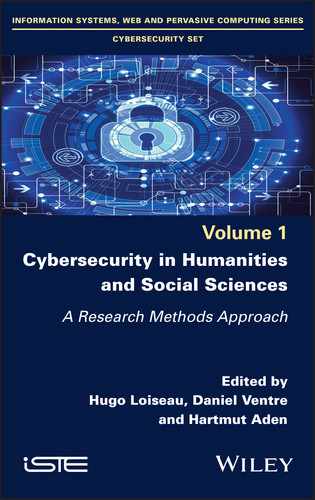The humanities and social sciences are interested in the cybersecurity object since its emergence in the security debates, at the beginning of the 2000s. This scientific production is thus still relatively young, but diversified, mobilizing at the same time political science, international relations, sociology , law, information science, security studies, surveillance studies, strategic studies, polemology. There is, however, no actual cybersecurity studies. After two decades of scientific production on this subject, we thought it essential to take stock of the research methods that could be mobilized, imagined and invented by the researchers. The research methodology on the subject "cybersecurity" has, paradoxically, been the subject of relatively few publications to date. This dimension is essential. It is the initial phase by which any researcher, seasoned or young doctoral student, must pass, to define his subject of study, delimit the contours, ask the research questions, and choose the methods of treatment. It is this methodological dimension that our book proposes to treat. The questions the authors were asked to answer were: how can cybersecurity be defined? What disciplines in the humanities and social sciences are studying, and how, cybersecurity? What is the place of pluralism or interdisciplinarity? How are the research topics chosen, the questions defined? How, concretely, to study cybersecurity: tools, methods, theories, organization of research, research fields, data ...? How are discipline-specific theories useful for understanding and studying cybersecurity? Has cybersecurity had an impact on scientific theories?
Table of Contents
- Cover
- Title Page
- Copyright Page
- Introduction
- 1 The “Science” of Cybersecurity in the Human and Social Sciences: Issues and Reflections
- 2 Definitions, Typologies, Taxonomies and Ontologies of Cybersecurity
- 3 Cybersecurity and Data Protection – Research Strategies and Limitations in a Legal and Public Policy Perspective
- 3.1. Introduction
- 3.2. Studying the complex relationship between cybersecurity and data protection: endangering privacy by combating cybercrime?
- 3.3. Methodological approaches and challenges for the study of cybersecurity – legal and public policy perspectives
- 3.4. Conclusion and outlook
- 3.5. References
- 4 Researching State-sponsored Cyber-espionage
- 4.1. Defining cybersecurity and cyber-espionage
- 4.2. Taxonomies of cyber-threats
- 4.3. The structure of this chapter
- 4.4. The significance of state-sponsored cyber-espionage
- 4.5. Research themes in state-sponsored cyber-espionage
- 4.6. Theorizing state-sponsored cyber-espionage in the social sciences
- 4.7. Research methodologies into state-sponsored cyber-espionage
- 4.8. Intellectual precision and objectivity in state-sponsored cyber-espionage research
- 4.9. Detecting state actors in cyber-espionage research
- 4.10. Identifying specific state actors in cyber-espionage research
- 4.11. Conclusion: researching a transformational subject
- 4.12. References
- 5 Moving from Uncertainty to Risk: The Case of Cyber Risk
- 5.1. Introduction
- 5.2. The scientific approach to move from uncertainty to risk
- 5.3. Learning about the data: the exploratory phase
- 5.4. Data cleansing
- 5.5. Statistical exploration on the various variables of the dataset
- 5.6. Univariate modeling for the relevant variables
- 5.7. Multivariate and dynamic modeling
- 5.8. Conclusion
- 5.9. Acknowledgments
- 5.10. References
- 6 Qualitative Document Analysis for Cybersecurity and Information Warfare Research
- 6.1. Introduction
- 6.2. Information warfare and cybersecurity
- 6.3. Researching information warfare and cybersecurity
- 6.4. Qualitative research methodologies for information warfare and cybersecurity
- 6.5. An analysis of national cybersecurity strategies
- 6.6. An analysis of the alignment of South Africa’s Cybercrimes Bill to international legislation
- 6.7. An analysis of the influence of classical military philosophy on seminal information warfare texts
- 6.8. Reflections on qualitative document analysis for information warfare and cybersecurity research
- 6.9. Conclusion
- 6.10. References
- 7 Anti-feminist Cyber-violence as a Risk Factor: Analysis of Cybersecurity Issues for Feminist Activists in France
- List of Authors
- Index
- Other titles from ISTE in Information Systems, Web and Pervasive Computing
- End User License Agreement
